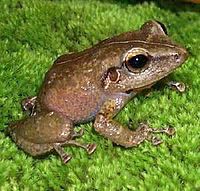Coquí
| Coquí (Puerto Rican Frog) | |
|---|---|

| |
| Common Coquí, Eleutherodactylus coqui | |
| Scientific classification | |
| Domain: | |
| Kingdom: | |
| Phylum: | |
| Subphylum: | |
| Class: | |
| Subclass: | |
| Order: | |
| Family: | |
| Subfamily: | |
| Genus: | Duméril and Bibron, 1841
|
| Species | |
| |
Coquí is the common name for several species of small frogs endemic to the island of Puerto Rico, onomatopoeically named for the loud sound males of two species make at night, the common coqui and the mountain coqui. The coquí is one of the most common frogs in the island of Puerto Rico. Many different species of small frogs create the family of the coquí.
More than 16 different species live in the island, 13 of which occur in the Caribbean National Forest. Other species of this genus can be found around the world: in Central and South America; and the Caribbean.
Taxonomy
Coquís belong to the Eleutherodactylus genus which in Greek means free toes. Eleutherodactylus contains over 700 different species that occur in the southern United States, Central America, South America, and the Caribbean.
Seventeen described species of coquís inhabit Puerto Rico. In 2007 a new species, the Coquí Llanero, was officially named Eleutherodactylus juanariveroi.[1]
Role in the Ecosystem
The coqui has essentially become the species which controls the population of herbivorous insects.
Population Decline
The decline of the coqui population has increased since the introduction in some manner of the Batrachochytrium dendrobatidis [2]. This fungus has been extremely effective against amphibians because it can cause skin infection. The coquis found in El Yunque are resistant to the B. dendrobatidis fungus at the expense of their size, which reduces the aptitude to survive in the wilderness (Burrowes, Longo and Rodriguez 2007). It was also seen that individuals that carry this fungus are more susceptible to frequent places were the B. dendrobatidis fungus is concentrated. Although the fungus frequents humid environments a higher rate of infection was seen in drier climates because coquis tend to cluster in humid areas within this drier climate (Burrowes, Longo and Rodriguez 2007).
Geographic distribution
The current record from the USGS[3] establishes that it has been identified in: Puerto Rico, Hawaii, St. Croix, St. John and St. Thomas, U.S. Virgin Islands, Dominican Republic, Vieques, and Florida.
At one point Louisiana was identified as another location but according to the USGS the Louisiana record was erroneous and was based on two pet coquis, both males, kept in a greenhouse for 2–3 years until killed off by a winter freeze [5].
Coquis have become established in Hawaii, where they are considered an invasive species. Coqui population density in Hawaii can reach 20,000 animals per acre and affects 50,000 acres (20,000 ha). Eradication campaigns are underway on Hawaiʻi and Maui.[4][5][6] Some groups favor its adoption.[7]
Eradication techniques include hand capture and spraying with a 12% solution of citric acid along with a certification program for nurseries to prevent them from acting as centers of contagion.[4]
See also
- Common Coquí
- Fauna of Puerto Rico
- List of amphibians and reptiles of Puerto Rico
- Coqui Francolin, also onomatopoeically named
References
- ^ Rios-López, N. and R. Thomas. 2007. A new species of palustrine Eleutherodactylus (Anura: Leptodactylidae) from Puerto Rico. Zootaxa 1512: 51–64
- ^ Burrowes, Patricia A. and Ana V. Longo. Persistence with Chytridiomycosis Does Not Assure Survival of Direct-developing Frogs. EcoHealth June 2010: p.185-195. ProQuest. Web. 5 June 2011.
- ^ [1]
- ^ a b Shafer, Jacob (November 18, 2010). "On the Front Lines of the Coqui Battle With Maui Invasive Species Committee". Retrieved November, 2010.
{{cite web}}: Check date values in:|accessdate=(help) - ^ [2]
- ^ [3]
- ^ [4]
